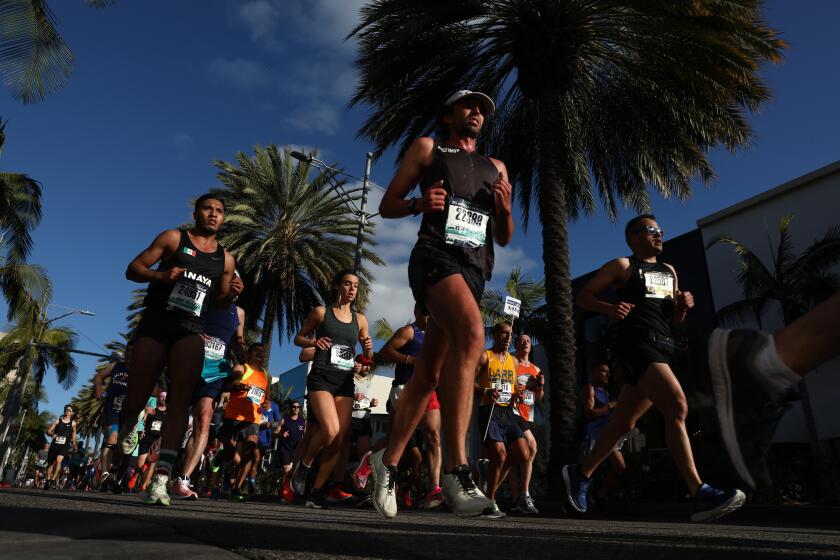Opinion: Why I’m getting rid of my smartwatch

The first thing I do each morning is check my watch — not for the time but for my sleep score.
As a runner, when the glowing red letters say my score — and my training readiness — are poor, I feel an instant dread. Regardless, I scroll on, inspecting my heart rate variability and stress level — snapshots that influence the tone I carry into the day.
What does dreading my smartwatch’s interpretation of my athletic competence say about me? That I have become a pawn in the gamification of health data.
Last year, electronics represented one of the largest proportions of total Black Friday sales, according to Deloitte. That’s when I bought my first smartwatch, a Garmin.
This year, I’m throwing it away.
After decades of jogging from Venice to Santa Monica, my workout partner took up pickleball, COVID struck and I developed arthritis. I needed a new exercise.
I was the perfect target. For several years, I had been preparing to run my first marathon. I watched fitness influencers, ultramarathoners and Olympians optimize their training with meticulous tracking and high-tech devices. I wanted in. I got the watch and joined Strava, a social media network for athletes.
Once I had a tracker on, sleep became sacred. I traded late-night socializing for it, confident that I’d cash in on race day. I built my day around my nights, transfixed by a false sense of control over my circadian rhythm.
Sleep, just like my running routine, had slowly morphed from a bodily function into a technological token of productivity.
I was hooked, emboldened by the illusion that I was training intuitively. I pushed hard when my Garmin nudged me, and even harder when I wanted to prove its metrics wrong. I began to run more for the PR (personal record) badge and “your fastest 5k!” notifications than for mental clarity and solitude.
Columbia researchers and NPR found that five minutes of movement every half an hour has substantial health benefits but can be a challenge in many jobs.
I ran because I loved it, and because I loved it, I fell prey to the Strava-fication of it. Suddenly, I was no longer running for myself. I was running for public consumption.
I realized this only when it literally became painfully obvious. An MRI found that the lingering pain I’d been ignoring in my heels — something my watch hadn’t picked up on — was caused by four running-induced stress fractures.
Recovering from the injury forced me to be sedentary, and during that time I’ve thought a lot about the app-ification of exercise culture.
I’ve realized that health optimization tools — the ones marketed as necessary for better sleep, a lower resting heart rate, higher VO2 max (a measure of how much oxygen your body absorbs) and so on — are designed to profit off our fitness anxiety. We track ourselves this way and that way, obsessing over our shortcomings to no apparent end. In doing so, we are deprogrammed from listening to innate physiological signals and reprogrammed to create shadow experiences such as posting our detailed workout stats or running paths on digital walls that no one is looking at.
A New Year’s resolution to run your age in 2022 could thwart midlife cynicism.
I’ve also learned that if you stop tracking, you will feel marginally but measurably better.
I don’t deny that today’s fitness gadgets are incredibly alluring, and in many ways tracking can be useful for training. I am convinced, however, that overreliance on the data collected by devices and apps — and the comparisons we draw from sharing it — can quickly corrupt and commodify what I find to be the true essence of running: being present.
When we aren’t tracking, when we are just doing, we can begin to reap the dull yet profound psychological benefits of endurance sports — the repetitive silence, the consistent failure — that can’t be captured in a post or monetized.
And when we endure the mundane and difficult aspects of a sport, over and over, we often make gains that are mindful as well as physical, becoming more aware of how and what we pay attention to. This is no small task. It takes discipline to remain aware, present and undistracted.
Exercise is a rare opportunity to allow our bodies’ movement to color our thoughts from one minute to the next. When we’re in motion, we don’t need to analyze our health metrics. We can learn to accept the moment and be humbled by our limitations.
Gift-giving season will attempt to convince you that you need devices to make your exercise more effective and efficient. There will be bright and beautiful advertisements featuring famous athletes. There will be a sleeker smartwatch and a cutting-edge GPS tracking shoe sole like that one Instagram keeps showing you. Be skeptical.
Freeing yourself, even temporarily, from the smartwatch or smartphone or smart-fill-in-the-blank that is tracking your every move is a challenge worth taking on. Because every walk or run or ride is a new story, and without fitness devices the path remains ours to choose.
Cate Twining-Ward is a climate policy consultant in New York City.













